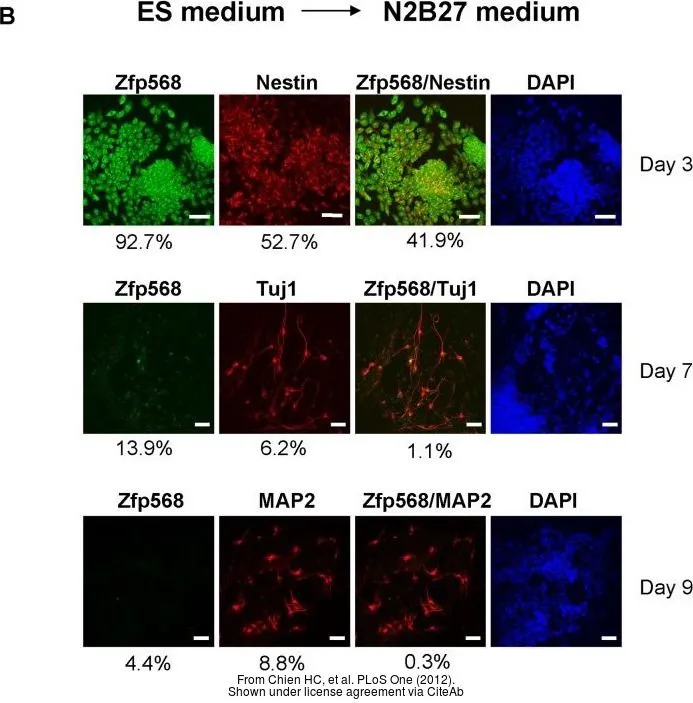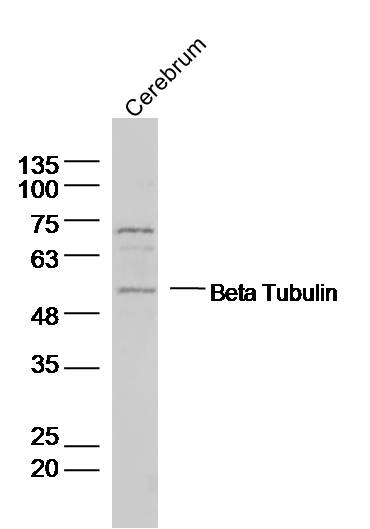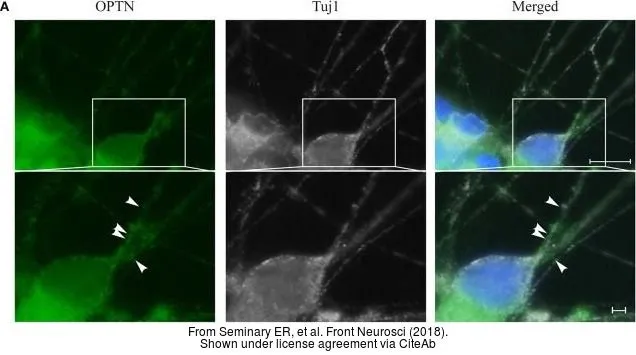![ICC/IF analysis of Neuro2a cells using GTX27751 beta Tubulin 3/ Tuj1 antibody [TU-20]. Green : Primary antibody Blue : DAPI Diultion : 3microg/ml ICC/IF analysis of Neuro2a cells using GTX27751 beta Tubulin 3/ Tuj1 antibody [TU-20]. Green : Primary antibody Blue : DAPI Diultion : 3microg/ml](https://www.genetex.com/upload/website/prouct_img/normal/GTX27751/GTX27751_20191028_ICC-IF_1_w_23060722_961.webp)
ICC/IF analysis of Neuro2a cells using GTX27751 beta Tubulin 3/ Tuj1 antibody [TU-20]. Green : Primary antibody Blue : DAPI Diultion : 3microg/ml
beta Tubulin 3/ Tuj1 antibody [TU-20]
GTX27751
ApplicationsFlow Cytometry, ImmunoFluorescence, Western Blot, ImmunoCytoChemistry, ImmunoHistoChemistry, ImmunoHistoChemistry Paraffin
Product group Antibodies
TargetTUBB3
Overview
- SupplierGeneTex
- Product Namebeta Tubulin 3/ Tuj1 antibody [TU-20]
- Delivery Days Customer9
- ApplicationsFlow Cytometry, ImmunoFluorescence, Western Blot, ImmunoCytoChemistry, ImmunoHistoChemistry, ImmunoHistoChemistry Paraffin
- CertificationResearch Use Only
- ClonalityMonoclonal
- Clone IDTU-20
- Concentration1 mg/ml
- ConjugateUnconjugated
- Gene ID10381
- Target nameTUBB3
- Target descriptiontubulin beta 3 class III
- Target synonymsCDCBM, CDCBM1, CFEOM3, CFEOM3A, FEOM3, TUBB4, beta-4, tubulin beta-3 chain, class III beta-tubulin, tubulin beta-4 chain, tubulin beta-III, tubulin, beta 3
- HostMouse
- IsotypeIgG1
- Protein IDQ13509
- Protein NameTubulin beta-3 chain
- Scientific DescriptionThis gene encodes a class III member of the beta tubulin protein family. Beta tubulins are one of two core protein families (alpha and beta tubulins) that heterodimerize and assemble to form microtubules. This protein is primarily expressed in neurons and may be involved in neurogenesis and axon guidance and maintenance. Mutations in this gene are the cause of congenital fibrosis of the extraocular muscles type 3. Alternate splicing results in multiple transcript variants. A pseudogene of this gene is found on chromosome 6. [provided by RefSeq, Oct 2010]
- Storage Instruction2°C to 8°C
- UNSPSC12352203
References
- The Efficiency of Direct Maturation: the Comparison of Two hiPSC Differentiation Approaches into Motor Neurons.Read more
- Ovarian cancer stem-like cells show induced translineage-differentiation capacity and are suppressed by alkaline phosphatase inhibitor. Liu KC et al., 2013 Dec, OncotargetRead more
- Evidence for a critical role of catecholamines for cardiomyocyte lineage commitment in murine embryonic stem cells. Lehmann M et al., 2013, PLoS OneRead more
- Intracranial extraskeletal myxoid chondrosarcoma : case report and literature review. Park JH et al., 2012 Sep, J Korean Neurosurg SocRead more
- Targeted disruption in mice of a neural stem cell-maintaining, KRAB-Zn finger-encoding gene that has rapidly evolved in the human lineage. Chien HC et al., 2012, PLoS OneRead more

![ICC/IF analysis of P-19 cells stimulated to neuronal differentiation by retinoic acid using GTX27751 beta Tubulin 3/ Tuj1 antibody [TU-20] and GTX27792 beta Tubulin antibody [TU-06]. Panel A : GTX27751 (Red) Panel B : GTX27751 (Red) and GTX27792 (Green) ICC/IF analysis of P-19 cells stimulated to neuronal differentiation by retinoic acid using GTX27751 beta Tubulin 3/ Tuj1 antibody [TU-20] and GTX27792 beta Tubulin antibody [TU-06]. Panel A : GTX27751 (Red) Panel B : GTX27751 (Red) and GTX27792 (Green)](https://www.genetex.com/upload/website/prouct_img/normal/GTX27751/GTX27751_20191028_ICC-IF_2_w_23060722_675.webp)



![ICC/IF analysis of SH-SY-5Y cells using GTX11314 beta Tubulin 3/ Tuj1 antibody [SDL.3D10] at 1:400(pink) with DAPI(blue). Cells were fixed and permeabilized with methanol followed by methanol:acetone.](https://www.genetex.com/upload/website/prouct_img/normal/GTX11314/GTX11314_20170605_ICCIF_w_23060500_832.webp)
![FACS analysis of A549 cells using GTX83356 beta Tubulin 3/ Tuj1 antibody [2E9]. Green : beta Tubulin 3/ Tuj1 Purple : negative control](https://www.genetex.com/upload/website/prouct_img/normal/GTX83356/GTX83356_20170912_FACS_w_23061322_791.webp)
![WB analysis of various cell lines using GTX83460 beta Tubulin 3/ Tuj1 antibody [5H2]. Loading : 35 ug per lane](https://www.genetex.com/upload/website/prouct_img/normal/GTX83460/GTX83460_3597_WB_w_23061419_857.webp)
